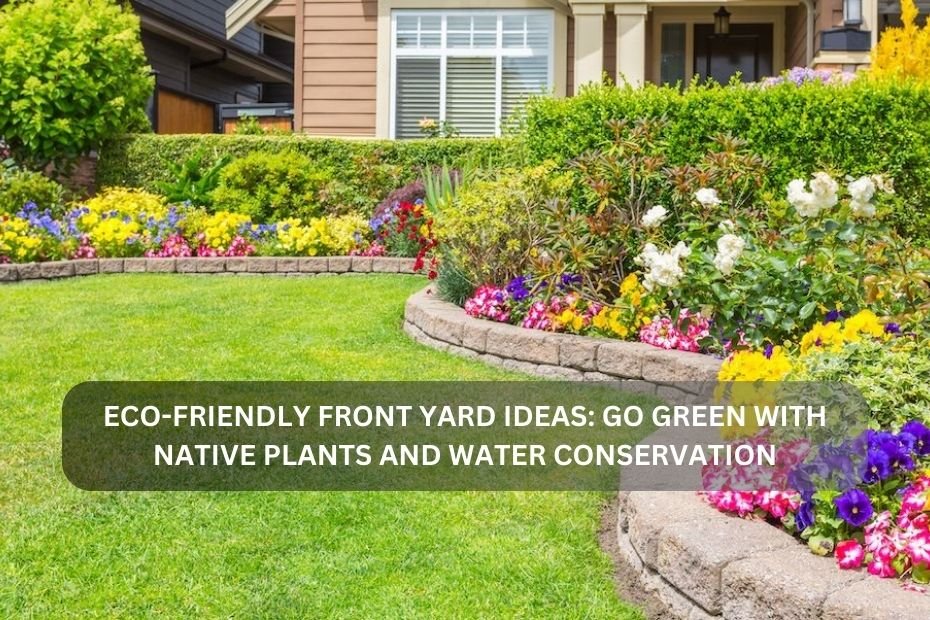Creating an eco-friendly front yard not only enhances the beauty of your home but also contributes to environmental sustainability. By incorporating native plants and implementing water conservation techniques, you can design a front yard that is both attractive and eco-conscious. Here are some effective strategies to achieve this:
1. Embrace Native Plants
Native plants are adapted to your local climate and soil conditions, making them easier to grow with minimal maintenance. They require less water, fertilizer, and pesticides compared to non-native species, which helps conserve resources and protect local ecosystems. Consider these benefits:
- Biodiversity Support: Native plants provide essential habitats for local wildlife, including birds, butterflies, and beneficial insects.
- Soil Health: Their deep root systems improve soil structure and prevent erosion.
- Low Maintenance: Once established, native plants thrive without excessive care.
Popular native plants include:
- Coneflowers: Attract pollinators and thrive in various conditions.
- Black-eyed Susans: Bright yellow flowers that are drought-tolerant.
- Ornamental Grasses: Add texture and movement to your landscape.
2. Implement Xeriscaping
Xeriscaping is a landscaping method designed for water conservation. It focuses on using drought-resistant plants, minimizing lawn areas, and optimizing irrigation practices. Here’s how to implement xeriscaping effectively:
- Choose Drought-Tolerant Plants: Select plants that require minimal watering once established, such as succulents, lavender, and ornamental grasses.
- Group Plants by Water Needs: Plant species with similar water requirements together to simplify irrigation.
- Use Mulch: Apply a layer of mulch around plants to retain moisture in the soil and suppress weeds.
3. Create Permeable Hardscapes
Traditional concrete surfaces can contribute to water runoff and erosion. Instead, consider permeable hardscapes, which allow rainwater to seep through the surface and replenish groundwater supplies. Options include:
- Gravel Pathways: These are aesthetically pleasing and promote drainage.
- Permeable Pavers: Available in various designs, they combine functionality with visual appeal for patios or walkways.
4. Incorporate Rain Gardens
A rain garden is a shallow depression planted with native vegetation that collects rainwater runoff from impervious surfaces like roofs or driveways. This helps filter pollutants while providing a habitat for wildlife. To create a rain garden:
- Choose the Right Location: Identify areas where water naturally collects.
- Select Native Plants: Use species that thrive in wet conditions, such as swamp milkweed or blue flag iris.
- Design for Drainage: Ensure the garden has proper drainage to prevent standing water.
5. Utilize Ground Covers
Ground covers are low-growing plants that spread quickly to cover bare soil, helping retain moisture and suppress weeds. They can replace traditional lawns in many areas:
- Creeping Thyme: A fragrant option that tolerates foot traffic and blooms beautifully.
- Sedum: Drought-tolerant and available in various textures and colors.
6. Install a Rain Harvesting System
Collecting rainwater is an effective way to conserve water for your garden. A rain harvesting system involves capturing rainwater from your roof and storing it in barrels for later use:
- Choose Appropriate Barrels: Ensure they have a lid to prevent mosquito breeding.
- Use the Water Wisely: Water your garden during dry spells or use it for cleaning outdoor areas.
7. Maximize Space with Vertical Gardening
If space is limited, consider vertical gardening, which allows you to grow plants upward rather than outward:
- Trellises and Arbors: Support climbing plants like beans or flowering vines while saving ground space.
- Wall Planters: Utilize vertical planters on fences or walls for herbs or small flowers.
8. Create Wildlife Habitats
Designing your front yard as a wildlife habitat can enhance biodiversity while providing natural pest control. Consider adding features such as:
- Birdhouses or Feeders: Attract birds that help control insect populations.
- Butterfly Gardens: Plant nectar-rich flowers like milkweed or lantana to attract butterflies.
Conclusion
Transforming your front yard into an eco-friendly space using native plants and water conservation techniques is not only beneficial for the environment but also enhances the beauty of your home. By embracing sustainable landscaping practices such as xeriscaping, creating permeable hardscapes, installing rain gardens, utilizing ground covers, implementing rain harvesting systems, maximizing vertical space, and fostering wildlife habitats, you can create a vibrant outdoor area that thrives year-round while contributing positively to your local ecosystem. With these ideas in mind, you can enjoy a beautiful front yard that reflects your commitment to sustainability!

